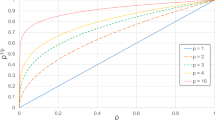Abstract
Monolithic Flexure-based Compliant Mechanisms (MFCM) can be used to conceive nonlinear springs with a desired load-displacement profile at one point of their structure. For a given MFCM topology, these particular springs can be conveniently dimensioned by resorting to the well-known Pseudo-Rigid-Body approximation, whose accuracy strongly depends on the modelling precision of the flexures’ principal compliance. For various types of flexures, closed-form solutions have been proposed, which express the compliance factors as functions of the flexure dimensions. Nonetheless, the accuracy of these relations is limited to slender, beam-like hinges undergoing rather small deflections. In order to overcome such limitations, this paper provides empirical equations, derived from finite element analysis, that can be used for the optimal dimensioning of circular, elliptical, and corner-filleted flexural hinges with general aspect ratios, on the basis of both principal compliance and maximum bearable stress. At first, an accuracy comparison with previously published results is provided. Then, as a case study, a nonlinear spring based on a double slider-crank MFCM and with a desired load-displacement profile is dimensioned and verified via finite element analysis. The corresponding MFCM prototype, produced by means of water jet cutting, is finally tested on a tensile stage. Both numerical and experimental results confirm that the aforementioned empirical equations outperform the closed-form solutions provided in the past literature when modelling thick cross-section hinges undergoing significant deflections.















Similar content being viewed by others
References
Howell L (2001) Compliant mechanisms. Wiley, New York
Chen S, Wang M (2007) Designing distributed compliant mechanisms with characteristic stiffness. ASME IDETC Conf Proc 2007:33–45
Berselli G, Vertechy R, Vassura G, Castelli VP (2011) Optimal synthesis of conically-shaped dielectric elastomer linear actuators: design methodology and experimental validation. IEEE/ASME Trans Mechatron 16(1):67–79
Mammano GS, Dragoni E (2011) Increasing stroke and output force of linear shape memory actuators by elastic compensation. Mechatronics 21(3):570–580
Rhoads JF, Shaw SW, Turner KL, Baskaran R (2005) Tunable microelectromechanical filters that exploit parametric resonance. ASME J Vib Acoust 127(5):423–430
Palli G, Berselli G, Melchiorri C, Vassura G (2011) Design of a variable stiffness actuator based on flexures. ASME Trans J Mech Robot 3(3):034501(5)
Howell LL, Midha A, Murphy MD (1994) Dimensional synthesis of compliant constant-force slider mechanisms. Mach Elem Mach Dyn DE 71:509–515
Nahar D, Sugar T (2003) Compliant constant-force mechanism with a variable output for micro/macro applications. IEEE ICRA Int Conf Robot Autom 1:318–323
Jutte CV, Kota S (2008) Design of nonlinear springs for prescribed load-displacement functions. J Mech Des 130(8):081403
Howell LL, Midha A (1995) Parametric deflection approximations for end-loaded, large-deflection beams in compliant mechanisms. J Mech Des 117(1):156–165
Timoshenko S (1976) Strength of materials. Krieger Publishing Company, New York
Su H-J (2008) A load independent pseudo-rigid-body 3R model for determining large deflection of beams in compliant mechanisms. ASME Conf Proc 2008(43260):109–121
Paros J, Weisbord L (1965) How to design flexure hinge. Mach Des 37(27):151–156
Smith ST et al (1997) Elliptical flexure hinges. Rev Sci Instrum 68(3):1474–1483
Lobontiu N, Paine J, Garcia E, Goldfarb M (2001) Corner-filleted flexure hinges. J Mech Des 123(3):346–352
Lobontiu N, Paine J, Garcia E, Goldfarb M (2002) Design of symmetric conic-section flexure hinges based on closed-form compliance equations. Mech Mach Theory 37:477–498
Chen G, Liu X, Du Y (2011) Elliptical-arc-fillet flexure hinges: toward a generalized model for commonly used flexure hinges. J Mech Des 133(8):081002
Zettl B, Szyszkowski W, Zhang WJ (2004) On systematic errors of two-dimensional finite element modeling of right circular planar flexure hinges. J Mech Des 127(4):782–787
Zettl B, Szyszkowski W, Zhang WJ (2004) Accurate low DOF modeling of a planar complaint mechanism with flexure hinges: the equivalent beam methodology. Precis Eng 1:1–9
Yong YK, Lu T, Handley D (2008) Review of circular flexure hinge design equations and derivation of empirical formulations. Precis Eng 32:63–70
Schotborgh W, Kokkeler F, Trager H, Houten FV (2005) Dimensionless design graphs for flexure elements and a comparison between three flexure elements. Precis Eng 29:41–47
Lobontiu N (2002) Compliant mechanisms: design of flexure hinges. CRC Press, Boca Raton
Meng Q, Li Y, Xu J (2013) New empirical stiffness equations for corner-filleted flexure hinges. Mech Sci 4:345–356
Björk A (1996) Numerical methods for least squares problems. Society for Industrial and Applied Mathematics, Philadelphia
Chen G, Jia J, Han Q, Wang Y (2005) Performance optimization of elliptical flexure hinge using a modified particle swarm algorithm. IEEE ICIT Int Conf Ind Technol 2005:1180–1185
Tseytlin Y (2002) Notch flexure hinges: an effective theory. Rev Sci Instrum 73(9):3363–3368
Author information
Authors and Affiliations
Corresponding author
Rights and permissions
About this article
Cite this article
Berselli, G., Meng, Q., Vertechy, R. et al. An improved design method for the dimensional synthesis of flexure-based compliant mechanisms: optimization procedure and experimental validation. Meccanica 51, 1209–1225 (2016). https://doi.org/10.1007/s11012-015-0276-z
Received:
Accepted:
Published:
Issue Date:
DOI: https://doi.org/10.1007/s11012-015-0276-z




